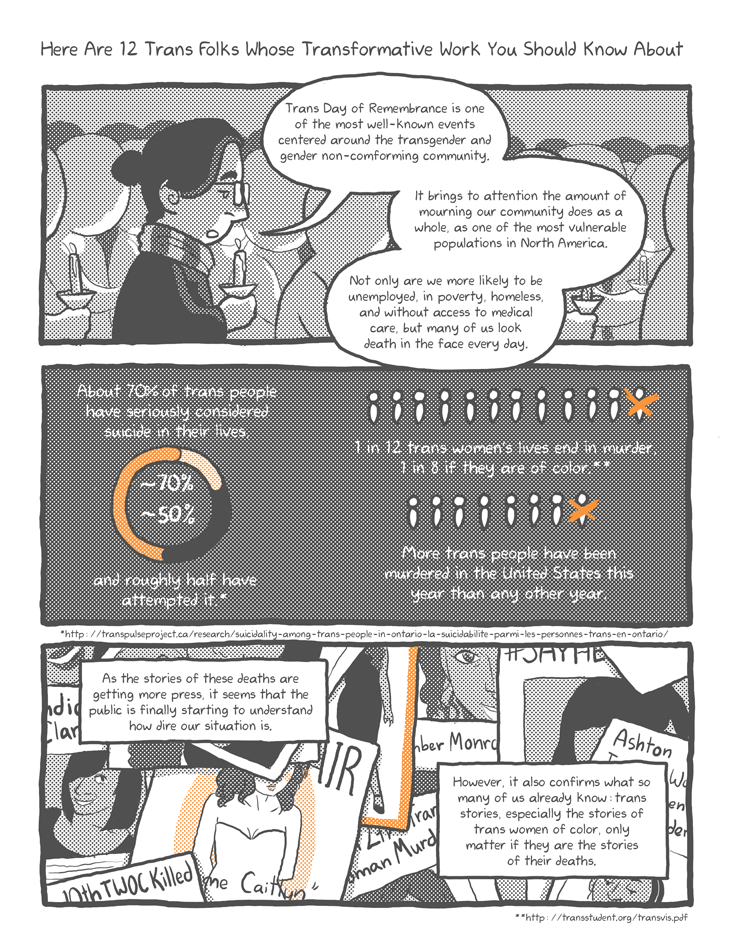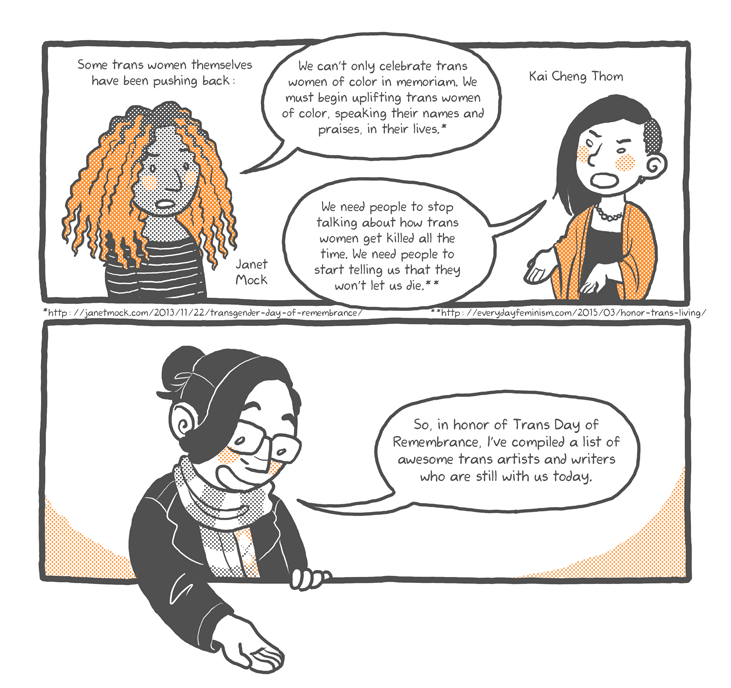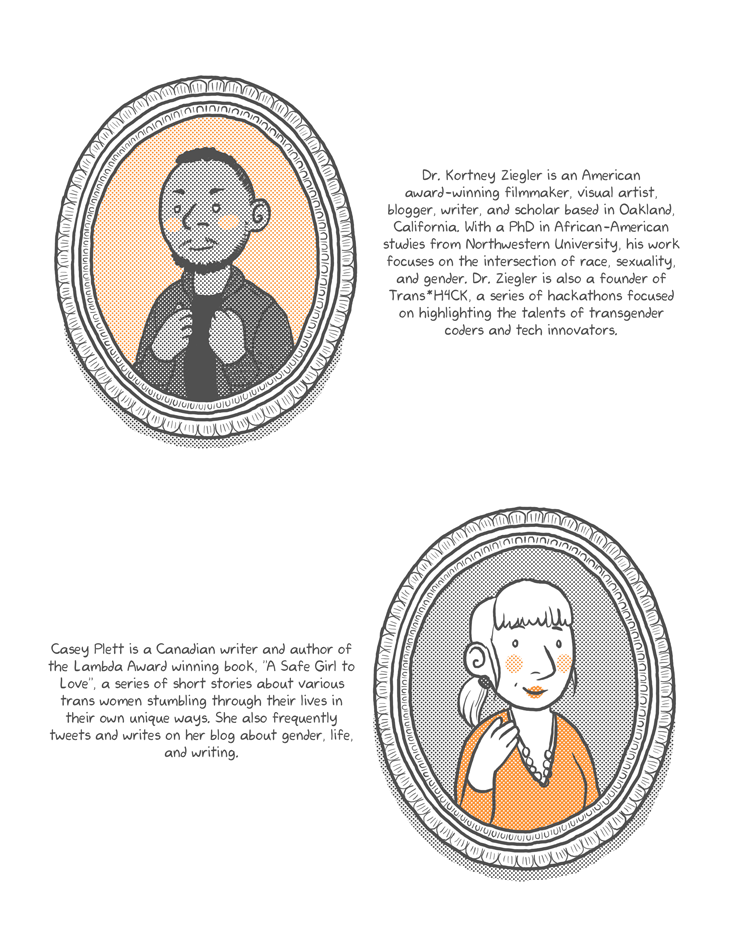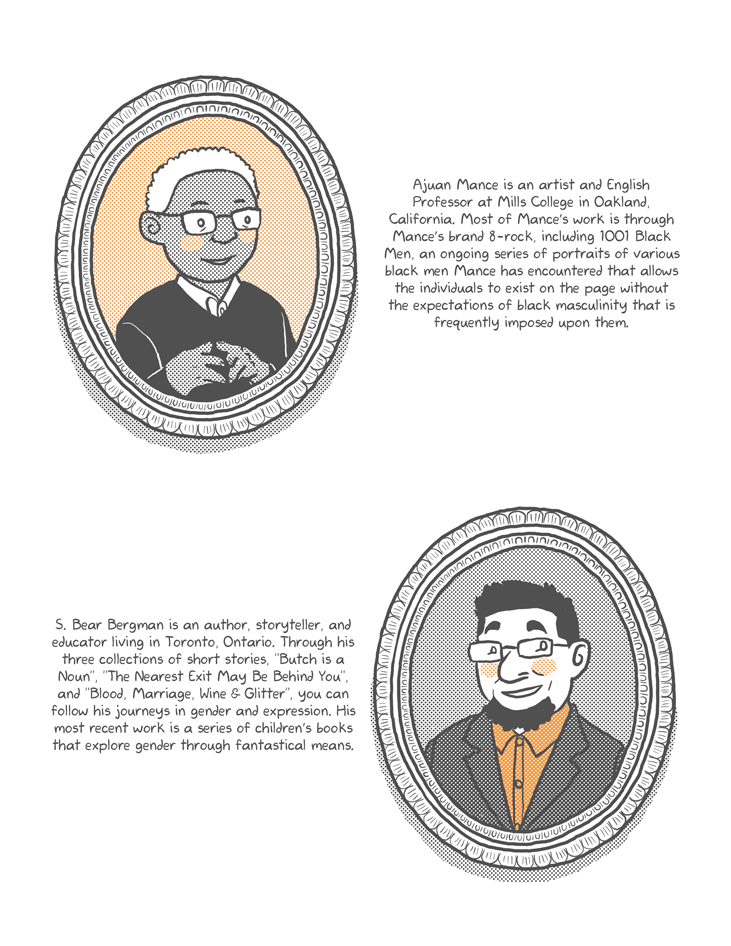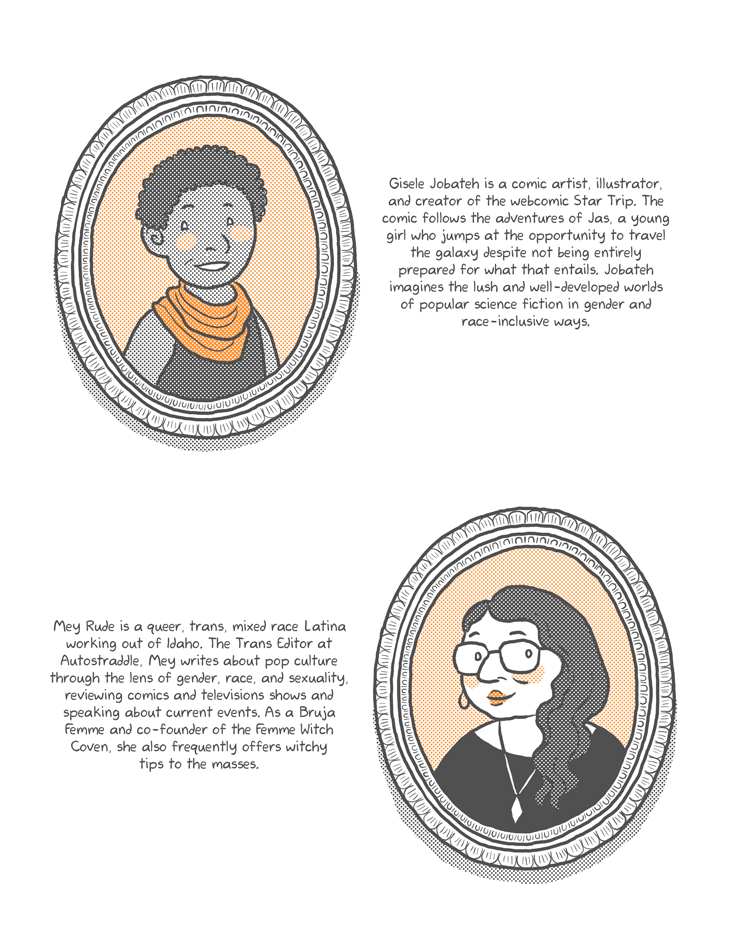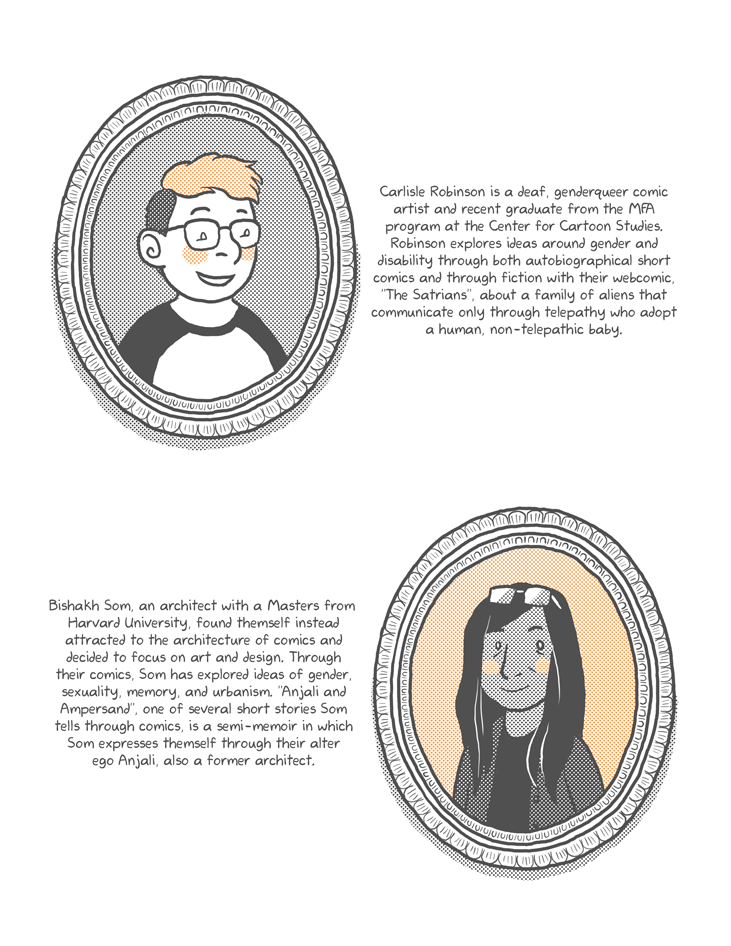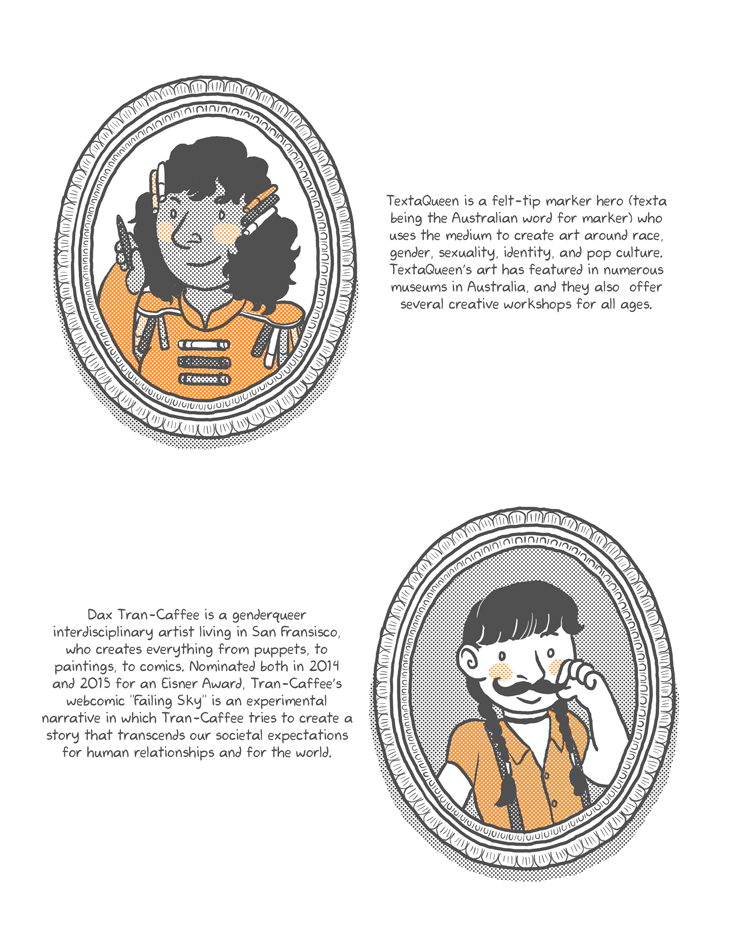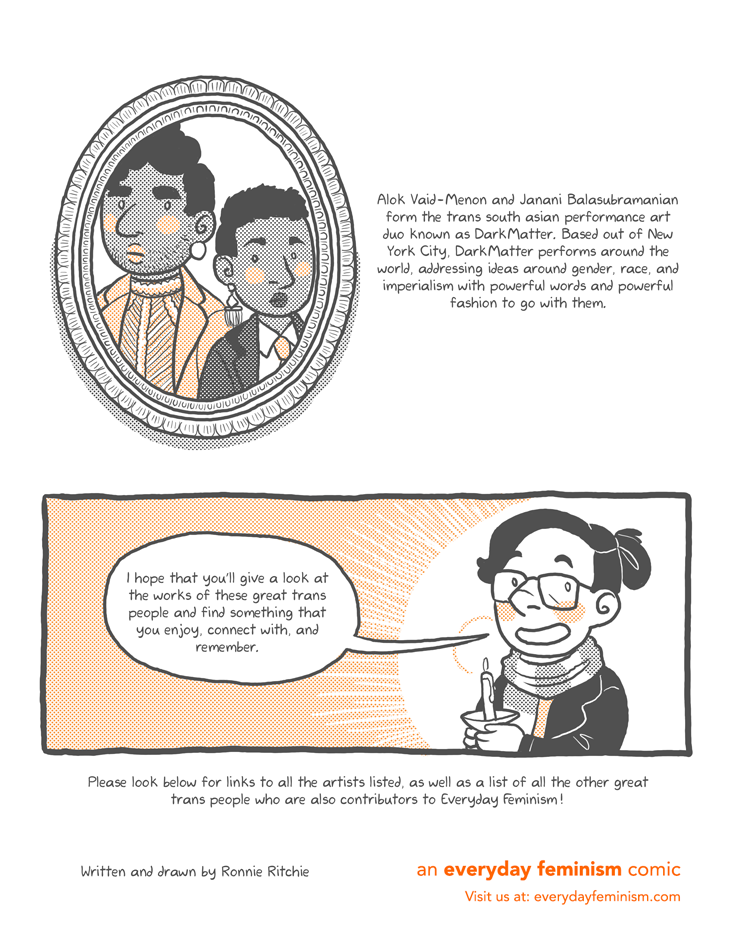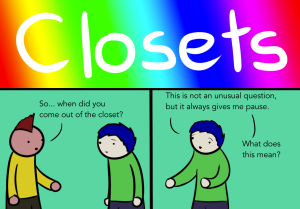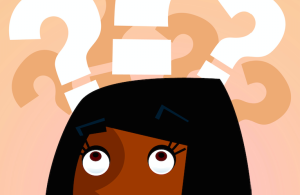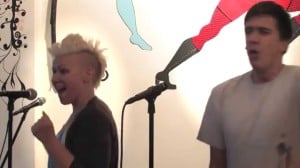Panel 1
(Ronnie stands in the midst of a crowd on a dark evening, holding a candle. Everyone else in the crowd also has candles. Ronnie looks back, addressing the reader.)
Ronnie: Trans Day of Remembrance is one of the most well-known events centered around the transgender and gender non-comforming community. It brings to attention the amount of mourning our community does as a whole, as one of the most vulnerable populations in North America. Not only are we more likely to be unemployed, in poverty, homeless, and without access to medical care, but many of us look death in the face every day.
Panel 2
(Two iconographs occupy this panel. The first one is a ring filled with two colors, half one color, then overlapped with the second color, which is filled slightly more. Inside are the numbers ~70% and ~50%. The second iconograph shows 12 figures, one crossed out, then another group of 8 with one figure crossed out.)
Text: About 70% of trans people have seriously considered suicide in their lives, and roughly half have attempted it. 1 in 12 trans women’s lives end in murder, 1 in 8 if they are of color. More trans people have been murdered in the United States this year than any other year.
Panel 3
(Several layers of articles and magazine pages lay over each other. Most headlines are reporting trans women of color who have been murdered. The only two exceptions are Caitlyn Jenner’s Vanity Fair cover, and Laverne Cox’s “The Transgender Tipping Point” cover for Time magazine.)
Text: As the stories of these deaths are getting more press, it seems that the public is finally starting to understand how dire our situation is. However, it also confirms what so many of us already know: trans stories, especially the stories of trans women of color, only matter if they are the stories of their deaths.
Panel 4
(Two trans women stand next to each other. One, Janet Mock, has long, curly brown hair, and another, Kai Cheng Thom, has long black hair with the sides shaved short. Both wear serious expressions.)
Text: Some trans women themselves have been pushing back:
Janet Mock: We can’t only celebrate trans women of color in memoriam. We must begin uplifting trans women of color, speaking their names and praises, in their lives.
Kai Cheng Thom: We need people to stop talking about how trans women get killed all the time. We need people to start telling us that they won’t let us die.
Panel 5
(Ronnie smiles, gesturing down to where the list of artists begins.)
Ronnie: So, in honor of Trans Day of Remembrance, I’ve compiled a list of awesome trans artists and writers who are still with us today.
Panel 6
(Image of a man with short curly black hair and a leather sports coat in a decorative frame.)
Text: Dr. Kortney Ziegler is an American award-winning filmmaker, visual artist, blogger, writer, and scholar based in Oakland, California. With a PhD in African-American studies from Northwestern University, his work focuses on the intersection of race, sexuality, and gender. Dr. Ziegler is also a founder of Trans*H4CK, a series of hackathons focused on highlighting the talents of transgender coders and tech innovators.
Panel 7
(Image of a woman with shoulder-length blond hair, bangs, and a small smile in a decorative frame. At the bottom of the frame is a name that reads “Casey Plett”.)
Text: Casey Plett is a Canadian writer and author of the Lambda Award winning book A Safe Girl to Love, a series of short stories about various trans women stumbling through their lives in their own unique ways. She also frequently tweets and writes on her blog about gender, life, and writing.
Panel 8
(Image of a person with a round face, glasses, and short, curly grey hair in a decorative frame.)
Text: Ajuan Mance is an artist and English Professor at Mills College in Oakland, California. Most of Mance’s work is through Mance’s brand 8-rock, including 1001 Black Men, an ongoing series of portraits of various black men Mance has encountered that allows the individuals to exist on the page without the expectations of black masculinity that is frequently imposed upon them.
Panel 9
(Image of a man with round cheeks, glasses, black hair, and a bushy black goatee in a decorative frame.)
Text: S. Bear Bergman is an author, storyteller, and educator living in Toronto, Ontario. Through his three collections of short stories, Butch is a Noun, The Nearest Exit May Be Behind You, and Blood, Marriage, Wine & Glitter, you can follow his journeys in gender and expression. His most recent work is a series of children’s books that explore gender through fantastical means.
Panel 10
(Image of a person with short, curly brown hair, a loose scarf, and a small smile.)
Text: Gisele Jobateh is a comic artist, illustrator, and creator of the webcomic “Star Trip”. The comic follows the adventures of Jas, a young girl who jumps at the opportunity to travel the galaxy despite not being entirely prepared for what that entails. Jobateh imagines the lush and well-developed worlds of popular science fiction in gender and race-inclusive ways.
Panel 11
(Image of a woman with round cheeks, glasses, and long, wavy brown hair over her shoulder in a decorative frame.)
Text: Mey Rude is a queer, trans, mixed race Latina working out of Idaho. The Trans Editor at Autostraddle, Mey writes about pop culture through the lens of gender, race, and sexuality, reviewing comics and televisions shows and speaking about current events. As a Bruja Femme and co-founder of the Femme Witch Coven, she also frequently offers witchy tips to the masses.
Panel 12
(Image of a person with a round face, glasses, and a short undercut that is lighter on the top and a darker brown on the sides in a decorative frame.)
Text: Carlisle Robinson is a deaf, genderqueer comic artist and recent graduate from the MFA program at the Center for Cartoon Studies. Robinson explores ideas around gender and disability through both autobiographical short comics and through fiction with their webcomic, “The Satrians”, about a family of aliens that communicate only through telepathy who adopt a human, non-telepathic baby.
Panel 13
(Image of a person with long, black hair and glasses on top of their head in a decorative frame.)
Text: Bishakh Som, an architect with a Masters from Harvard University, found themself instead attracted to the architecture of comics and decided to focus on art and design. Through their comics, Som has explored ideas of gender, sexuality, memory, and urbanism. “Anjali and Ampersand”, one of several short stories Som tells through comics, is a semi-memoir in which Som expresses themself through their alter ego Anjali, also a former architect.
Panel 14
(Image of a person with long curly dark hair in a superhero costume, outfitted with multicolored markers in a decorative frame.)
Text: TextaQueen is a felt-tip marker hero (texta being the Australian word for marker) who uses the medium to create art around race, gender, sexuality, identity, and pop culture. TextaQueen’s art has featured in numerous museums in Australia, and they also offer several creative workshops for all ages.
Panel 15
(Image of a person with long dark hair in two braids and a long thin moustache curled at the ends in a decorative frame.)
Text: Dax Tran-Caffee is a genderqueer interdisciplinary artist living in San Fransisco, who creates everything from puppets, to paintings, to comics. Nominated both in 2014 and 2015 for an Eisner Award, Tran-Caffee’s webcomic “Failing Sky” is an experimental narrative in which Tran-Caffee tries to create a story that transcends our societal expectations for human relationships and for the world.
Panel 16
(Image of two people, one taller and one shorter, both with short black hair that is longer and curlier on top. Both are wearing dramatic clothing with bright lipstick. They are in a decorative frame.)
Text: Alok Vaid-Menon and Janani Balasubramanian form the trans south asian performance art duo known as DarkMatter. Based out of New York City, DarkMatter performs around the world, addressing ideas around gender, race, and imperialism with powerful words and powerful fashion to go with them.
Panel 17
(Ronnie smiles warmly, holding the same candle as in the first panel of the comic.)
Ronnie: I hope that you’ll give a look at the works of these great trans people and find something that you enjoy, connect with, and remember.
Text: Please look below for links to all the artists listed, as well as a list of all the other great trans people who are also contributors to Everyday Feminism!


